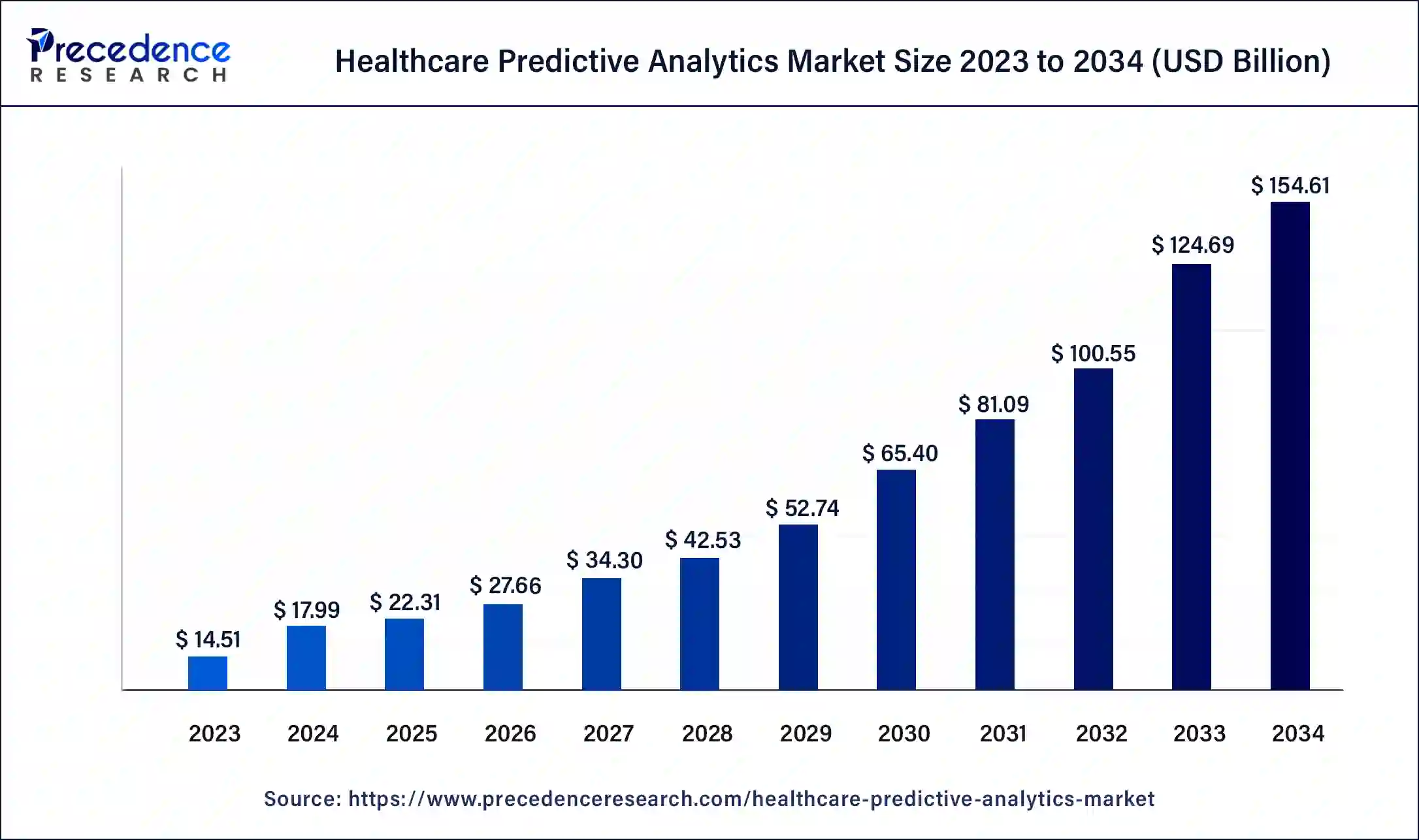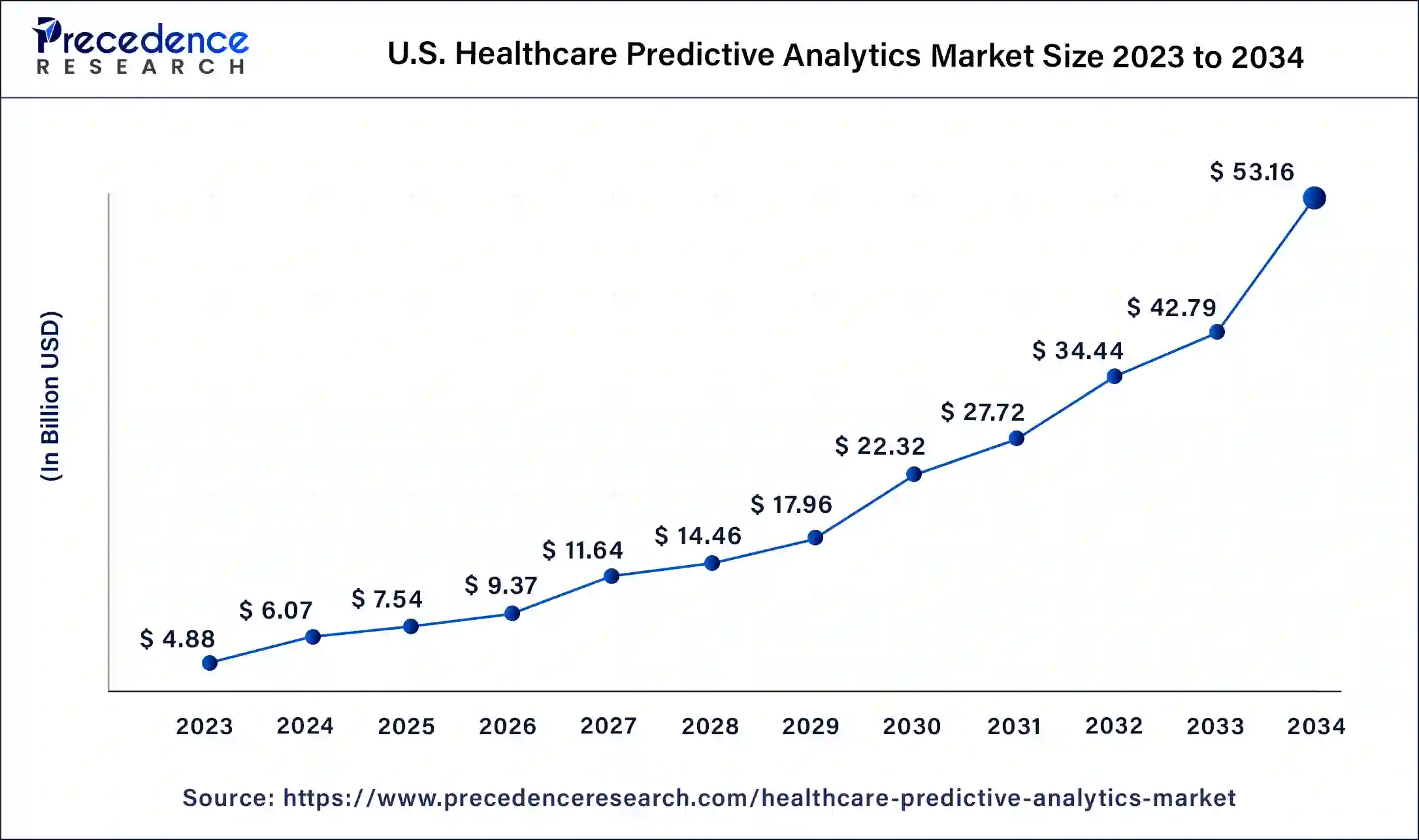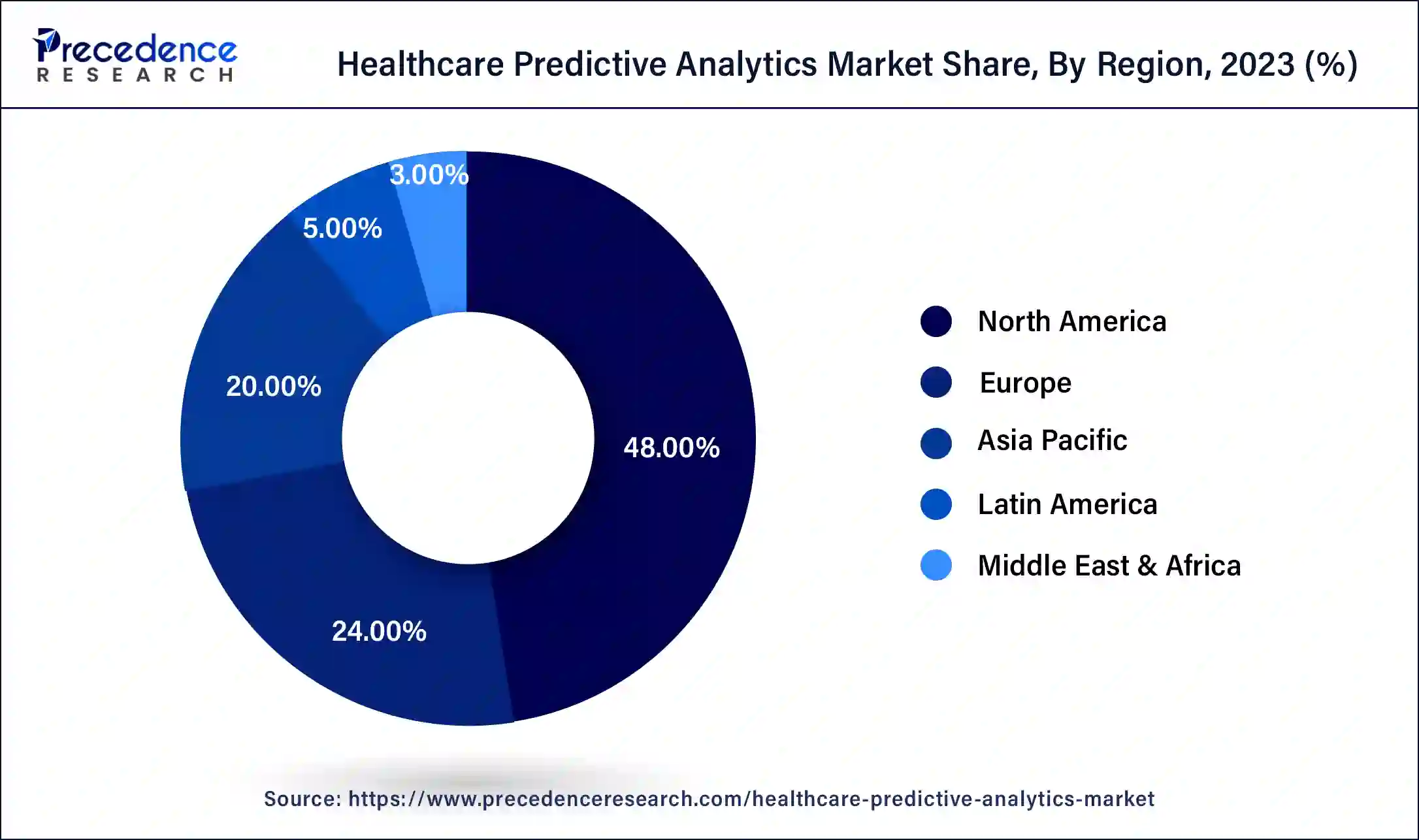List of Contents
Healthcare Predictive Analytics Market Size to Worth USD154.61 Bn by 2024
The global healthcare predictive analytics market size was USD 14.51 billion in 2023, accounted for USD 17.99 billion in 2024, and is expected to reach around USD 154.61 billion by 2034, expanding at a CAGR of 24% from 2024 to 2034.The North America healthcare predictive analytics market size reached USD 6.96 billion in 2023.

Healthcare Predictive Analytics Market Key Takeaways
- The North America region contributed more than 48% of revenue share in 2023.
- Asia Pacific is estimated to expand the fastest CAGR between 2024 and 2034.
- By end-use, the payers segment has held the largest market share of 36% in 2023.
- By end-use, the providers segment is anticipated to grow at a remarkable CAGR of 26.2% between 2024 and 2034.
- By application, the financial segment generated over 34% of revenue share in 2023.
- By application, the population health segment is expected to expand at the fastest CAGR over the projected period.
U.S. Healthcare Predictive Analytics Market Size and Growth 2024 to 2034
The U.S. healthcare predictive analytics market size was estimated at USD 4.88 billion in 2023 and is predicted to be worth around USD 53.16 billion by 2034, at a CAGR of 24.2% from 2024 to 2034.

North America has held the largest revenue share of 48% in 2023. North America holds a major share in the healthcare predictive analytics market due to robust healthcare infrastructure, widespread adoption of advanced technologies, and a strong focus on improving patient outcomes. The region benefits from substantial investments in healthcare IT, supportive government initiatives, and a high awareness of predictive analytics benefits. The presence of key market players, research institutions, and a proactive approach to incorporating data-driven solutions in healthcare contribute to North America's leadership in shaping and expanding the healthcare predictive analytics market.

Asia Pacific is estimated to observe the fastest expansion. Asia Pacific dominates the healthcare predictive analytics market, driven by a surge in healthcare digitization, technological advancements, and heightened investments in the sector. The region's increasing focus on predictive analytics stems from the rising burden of chronic diseases and the imperative for more effective healthcare solutions. Government backing, a substantial population base, and the widespread adoption of telehealth also play pivotal roles in establishing the Asia-Pacific region as a key driver in shaping the trajectory of the predictive analytics market in healthcare.
Market Overview
Healthcare predictive analytics involves using data, statistical algorithms, and machine learning techniques to identify future outcomes in the healthcare domain. By analyzing historical patient data, such as electronic health records and diagnostic information, predictive analytics helps healthcare professionals make informed decisions about patient care, resource allocation, and treatment plans. This approach enables early detection of potential health issues, personalized interventions, and optimization of healthcare processes.
Predictive analytics in healthcare holds the promise of improving patient outcomes, streamlining operational processes, and reducing costs. It allows healthcare providers to proactively address health risks, allocate resources efficiently, and customize treatment strategies based on individual patient profiles. This technology is applicable across various healthcare domains, including disease prevention, patient management, and hospital administration. With ongoing technological advancements and the increasing availability of data, healthcare predictive analytics is continually advancing, contributing to a more data-driven and patient-focused approach in the medical field.
Healthcare Predictive Analytics Market Growth Factors
- Increasing Adoption of Electronic Health Records (EHR): The widespread implementation of EHR systems provides a rich source of structured data, fueling the growth of healthcare predictive analytics.
- Rising Demand for Personalized Medicine: The shift towards personalized treatment plans drives the need for predictive analytics to tailor interventions based on individual patient data and characteristics.
- Advancements in Machine Learning and AI: Continuous developments in machine learning algorithms and artificial intelligence enhance the accuracy and efficiency of predictive analytics models in healthcare.
- Growing Healthcare Data Volumes: The exponential increase in healthcare data, including genomics and patient-generated data, creates opportunities for predictive analytics to extract valuable insights.
- Focus on Managing Population Health: Healthcare providers are increasingly turning to predictive analytics to handle population health, identify high-risk groups, and allocate resources efficiently.
- Transition to Value-Based Care: The move from fee-for-service to value-based care models is prompting the use of predictive analytics to enhance patient outcomes and reduce costs.
- Government Support and Regulations: Supportive government policies and regulations are encouraging the integration of predictive analytics for better decision-making and enhanced patient care.
- Rising Chronic Disease Rates: The increasing prevalence of chronic diseases necessitates predictive analytics for early detection, preventive measures, and efficient management.
- Integration with Wearable Devices: The integration of predictive analytics with wearable health devices enables real-time monitoring, fostering proactive healthcare interventions.
- Telehealth Expansion: The growth of telehealth services creates opportunities for predictive analytics to remotely monitor patients and predict potential health issues.
- Enhanced Data Interoperability: Improved interoperability standards facilitate seamless data exchange, enabling more comprehensive and accurate predictive analytics in healthcare.
- Technological Convergence: Integration with other technologies, such as the Internet of Things (IoT) and blockchain, enhances the capabilities of predictive analytics in healthcare.
- Increasing Healthcare IT Investments: Growing investments in healthcare IT infrastructure support the implementation and scalability of predictive analytics solutions.
- Focus on Early Disease Detection: Predictive analytics plays a crucial role in early disease detection, improving treatment outcomes and reducing the overall burden on healthcare systems.
- Big Data Analytics in Healthcare: The utilization of big data analytics allows for the extraction of meaningful patterns and trends, contributing to more effective predictive models.
- Patient-Centric Approach: The shift towards patient-centric care models encourages the use of predictive analytics to deliver personalized and proactive healthcare solutions.
- Cybersecurity Measures: Heightened awareness of cybersecurity in healthcare promotes the responsible use and protection of sensitive patient data in predictive analytics applications.
- Increasing Partnerships and Collaborations: Collaborations between technology providers, healthcare organizations, and research institutions drive innovation and adoption of predictive analytics.
- Demand for Predictive Analytics in Drug Discovery: Pharmaceutical companies leverage predictive analytics for drug discovery and development, optimizing research processes.
- Global Health Crisis Preparedness: The lessons learned from global health crises, such as the COVID-19 pandemic, emphasize the importance of predictive analytics in preparing for and managing public health emergencies.
- IBM revenue for the twelve months ending June 30, 2023 was $60.525B, a 1.42% increase year-over-year. IBM annual revenue for 2022 was $60.53B, a 5.54% increase from 2021. IBM annual revenue for 2021 was $57.35B, a 3.93% increase from 2020.
Market Scope
| Report Coverage | Details |
| Growth Rate from 2024 to 2034 | CAGR of 24% |
| Market Size in 2023 | USD 14.51 Billion |
| Market Size in 2024 | USD 17.99 Billion |
| Market Size by 2034 | USD 154.61 Billion |
| Largest Market | North America |
| Base Year | 2023 |
| Forecast Period | 2024 to 2034 |
| Segments Covered | By End-use and By Application |
| Regions Covered | North America, Europe, Asia-Pacific, Latin America, and Middle East & Africa |
Market Dynamics
Driver
Rising adoption of electronic health records and growing emphasis on population health management
The rising adoption of electronic health records significantly boosts the demand for healthcare predictive analytics. As healthcare providers transition from paper-based records to digital systems, a vast amount of structured and unstructured data becomes available. Predictive analytics leverages this wealth of information to extract valuable insights, enabling healthcare professionals to make data-driven decisions. The comprehensive nature of EHR data, encompassing patient histories, diagnoses, and treatments, empowers predictive analytics to enhance patient care, streamline operations, and improve overall healthcare outcomes.
Simultaneously, the growing emphasis on population health management fuels the surge in demand for predictive analytics solutions. Population health initiatives aim to proactively address the health needs of entire communities, requiring robust tools for risk identification, resource allocation, and preventive interventions. Predictive analytics plays a pivotal role in this landscape by analyzing diverse datasets to identify patterns, assess population health risks, and optimize strategies for delivering targeted and effective healthcare services. The combination of EHR adoption and a focus on population health management synergistically propels the expansion of the healthcare predictive analytics market.
Restraint
Limited interoperability and data privacy concerns
Limited interoperability and data privacy concerns pose significant challenges to the growth of the healthcare predictive analytics market. The lack of seamless integration among various healthcare IT systems and data sources inhibits the efficient exchange of information, hindering the comprehensive utilization of predictive analytics tools. This limitation restricts healthcare organizations from harnessing the full potential of these analytics solutions to improve patient care and operational efficiency. Simultaneously, data privacy concerns are a substantial restraint.
The sensitive nature of healthcare data, coupled with stringent privacy regulations, creates hesitancy among healthcare providers and patients to fully embrace predictive analytics. Fears of unauthorized access, data breaches, and misuse of personal health information contribute to a cautious approach in adopting these technologies. Addressing these challenges through improved interoperability standards and robust data privacy measures is crucial for unlocking the full potential of healthcare predictive analytics and fostering trust among stakeholders in the healthcare ecosystem.
Opportunity
Patient engagement platforms and telehealth integration
Patient engagement platforms and telehealth integration are pivotal in creating significant opportunities for the healthcare predictive analytics market. Patient engagement platforms, which facilitate active participation in healthcare, generate rich datasets reflecting patient behaviors and preferences. Predictive analytics can leverage this information to personalize interventions, enhance treatment adherence, and predict health outcomes more accurately.
Additionally, the rapid expansion of telehealth services provides a continuous stream of real-time patient data, enabling predictive analytics to monitor health trends, identify risk factors, and deliver timely insights. Integrating predictive analytics into telehealth enhances remote patient monitoring, allowing healthcare providers to proactively address emerging health issues, optimize care plans, and allocate resources effectively. These opportunities signify a transformative shift towards more data-driven and patient-centric healthcare practices, improving both the quality of care and patient outcomes.
End-use Insights
The payers segment had the highest market share of 36% in 2023. Within the healthcare predictive analytics market, payers denote entities, often insurance companies, responsible for covering healthcare expenses. Payers employ predictive analytics to evaluate risks, curb fraud, and refine reimbursement strategies. Current trends in this sector involve an increasing commitment to value-based care. Payers leverage predictive analytics to bolster care coordination, curtail expenses, and enhance patient outcomes.
Furthermore, rising reliance on data-driven decision-making is observed, aiding in the identification of high-risk populations, the implementation of preventive measures, and the evolution of more streamlined and cost-efficient payer models in the dynamic healthcare landscape.
The providers segment is anticipated to expand at a significant CAGR of 26.2% during the projected period. In the healthcare predictive analytics market, providers refer to healthcare organizations such as hospitals, clinics, and medical practices. Providers leverage predictive analytics to enhance patient care, optimize resource allocation, and improve operational efficiency. Trends in this sector include the increasing adoption of predictive analytics for population health management, personalized treatment plans, and the integration of advanced technologies like artificial intelligence. Providers are focusing on leveraging predictive analytics to deliver proactive and data-driven healthcare solutions, ultimately improving patient outcomes and streamlining healthcare delivery processes.
Application Insights
According to the application, the financial has held 34% revenue share in2023. In the healthcare predictive analytics market, financial applications involve optimizing resource allocation, cost management, and revenue prediction. This includes predicting patient admission rates, optimizing staffing levels, and identifying areas for cost reduction. Trends indicate an increasing focus on value-based care models, where predictive analytics plays a crucial role in improving financial performance by aligning incentives with patient outcomes. As healthcare organizations prioritize efficiency and cost-effectiveness, predictive analytics applications in finance continue to evolve, driving smarter financial decision-making and fostering sustainability in the healthcare industry.
The population health segment is anticipated to expand fastest over the projected period. Population health in healthcare predictive analytics refers to the proactive management of health outcomes and care delivery for entire populations. Predictive analytics in population health analyzes diverse datasets to identify health trends, risk factors, and opportunities for intervention. Trends include a growing focus on preventive care, targeted resource allocation, and the use of predictive models to identify high-risk individuals. This approach optimizes healthcare strategies, improving overall community health, and aligns with the industry's shift towards value-based care, emphasizing better outcomes and cost-effectiveness for larger demographic groups.
Healthcare Predictive Analytics Market Companies
- IBM Corporation
- Oracle Corporation
- Allscripts Healthcare, LLC
- Cerner Corporation
- Inovalon Holdings, Inc.
- Epic Systems Corporation
- McKesson Corporation
- SAS Institute Inc.
- Health Catalyst
- Optum, Inc. (a part of UnitedHealth Group)
- MedeAnalytics, Inc.
- Siemens Healthineers
- GE Healthcare
- Microsoft Corporation
- Welltok, Inc.
Recent Developments
- In October 2022, Oracle revealed that WellSpan Health had chosen Oracle Fusion Cloud-Based Predictive Analytics Application Suite to enhance operational unity and augment business visibility.
- May 2022witnessed a collaboration between IBM and Amazon Web Services, Inc. to deliver Software as a Service (SaaS) on AWS.
- In November 2021, Allscripts Healthcare, LLC shared that Next Level Urgent Care had opted for the Allscripts Touchworks platform and Microsoft Azure to enhance Electronic Health Record (EHR) processes across all its locations.
- Cerner made headlines in January 2021 by acquiring Kantar Group for USD 375.0 million, aiming to establish a leading data insights and clinical research platform to improve safety, efficiency, and efficacy in clinical research.
Segments Covered in the Report
By End-use
- Payers
- Providers
- Others
By Application
- Operations Management
- Financial
- Population Health
- Clinical
By Geography
- North America
- Europe
- Asia-Pacific
- Latin America
- Middle East and Africa
For inquiries regarding discounts, bulk purchases, or customization requests, please contact us at sales@precedenceresearch.com
Frequently Asked Questions
Ask For Sample
No cookie-cutter, only authentic analysis – take the 1st step to become a Precedence Research client